
4.5 Unsachgemäße Projektierung, Montage, Installation, Inbetriebnahme,
Instandhaltung oder Reinigung
Grundlegende Arbeiten wie Installation, Inbetriebnahme, Instandhaltung oder
Reinigung des Geräts dürfen nur nach gültigen nationalen Bestimmungen des
Einsatzlandes und von qualifizierten Personen durchgeführt werden.
Ansonsten kann der Explosionsschutz aufgehoben werden. Explosionen mit
tödlichen oder schweren Verletzungen von Personen können die Folge sein.
•Bei Einsatz in Zone 1 oder Zone 2 ist das Gerät in ein schützendes Gehäuse
oder einen Schrank entsprechend der IEC/EN 60079-0 einzubauen, die eine
geeignete Schutzart bieten.
•Bei Einsatz in Zone 21 oder Zone 22 ist das Gerät in ein schützendes
Gehäuse oder einen Schrank entsprechend der IEC/EN 60079-31
einzubauen, die eine geeignete Schutzart bieten.
•Gerät nur mit korrekt positionierter IP30-Abdeckung über den
Anschlussklemmen betreiben (Schraubenköpfe der Klemme von oben nicht
sichtbar).
•Reparaturen am Gerät nur durch R. STAHL durchführen lassen.
•Gerät nur mit feuchtem Tuch und ohne kratzende, scheuernde oder
aggressive Reinigungsmittel oder Lösungen schonend reinigen.
•Gerät ausschließlich mit Original-Zubehör von R. STAHL Schaltgeräte
einsetzen.
5. Geräteaufbau (2)
6. Produktauswahl und Projektierung
siehe Handbuch
7. Montage und Installation
7.1 Montage (3)
•Gerät auf einer Hutschiene (TH35 gemäß EN 60715) montieren.
•Seitlich zu anderen Geräten einen Abstand von ≥ 5 mm einhalten.
7.2 Installation
Hilfsenergie anschließen
Zum Anschluss der Hilfsenergie verfügt das Gerät über eine
2-polige Ex e-Klemme.
Der Anschlussquerschnitt beträgt:
•Verbindungsleitungen abisolieren (9 mm).
•Bei feindrähtigen Adern: Aderendhülsen verwenden.
•Befestigungsschrauben der IP30-Abdeckung leicht lösen.
•Abdeckung verschieben bis die Schraubenköpfe der Klemme von oben
sichtbar sind.
•Versorgungsspannung an die Klemme + und - anschließen.
•Klemmen festziehen (Anzugsdrehmoment: 0,4 ... 0,5 Nm).
•IP30-Abdeckung verschieben bis die Abdeckung bündig am Gehäuse anliegt.
•Befestigungsschrauben fixieren.
Potenzialausgleich anschließen
•M5 x 1-Bolzen ("Case Ground") auf dem Gerät mit dem Potenzialausgleich
verbinden.
RS485-Leitungsschirm auflegen
Je nach zu erwartenden Störeinflüssen und Installation kann zwischen
kapazitiver und direkter (harter) Erdung ausgewählt werden. Der Schirm ist ab
Werk kapazitiv mit dem Anschluss für die Schirmerdung (2, Gerätelement #4)
verbunden.
Dazu ist eine Isolierscheibe zwischen Schraubenkopf und Leitungsschirm
eingesetzt.
•Direkte Erdung wählen: Schraube herausdrehen, Isolierscheibe entfernen und
die Schraube wieder eindrehen.
•Falls der Anschluss für die Schirmerdung mit dem Gehäusepotenzial
"Case Ground" verbunden werden soll:
M5 x 1-Bolzen mit dem M5 × 1-Bolzen ("Case Ground") verbinden.
Medienkonverter an Feldbus anschließen
Die Feldbusschnittstelle ist als 9-polige Sub-D-Buchse ausgeführt.
•Gerät mit einem für Ex-Anwendungen zugelassenen Sub-D-Steckverbinder
(z.B. Art. Nr. 162693 (gerade) oder 201805 (gewinkelt)) an den Feldbus
anschließen.
•Befestigungsschrauben des Sub-D-Steckers anziehen.
# Gerätelement Beschreibung
1 Gehäusepotential Anschluss des Gehäuses an den Potentialausgleich
2 LED-Anzeigen "PWR": Anzeige Hilfsenergie
"RS485-IS": Anzeige Status RS485-IS-Schnittstelle
"Port A": Anzeige Status LWL-Port A
"Port B": Anzeige Status LWL-Port B
3 Klemme Fehler-
meldeausgang
Signalisierung von Fehlerzuständen
4 Schirmerdung Anschluss des Schirms der RS485-Leitung an den
Potentialausgleich
5 LWL-Ports Anschluss der Lichtwellenleiter
6 Klemme Hilfsenergie Anschluss der Hilfsenergie
7 IP30-Abdeckung Schutz für Anschluss der Hilfsenergie
8 Drehschalter Auswahl der Baudrate und des Betriebsmodus
9 Sub-D-Buchse RS485-IS-Schnittstelle
10 Schraube Auswahl der Schirmerdung - kapazitiv oder
direkt (hart)
GEFAHR! Explosionsgefahr durch zündfähige Funken bei Einsatz in
Zone 1 und Zone 2!
Nichtbeachten führt zu schweren oder tödlichen Verletzungen.
•Gerät nur im spannungslosen Zustand montieren und anschließen.
•Gerät in ein Gehäuse nach EN IEC 60079-0 mit einer Schutzart von
min. IP54 montieren.
•Gegebenenfalls durch Wärmeableitungsmaßnahmen sicherstellen,
dass in diesem Gehäuse die zulässige Betriebstemperatur des Geräts
auch bei ungünstigen Umgebungsbedingungen nicht überschritten
wird.
•Bei bereichsübergreifender Verbindung über den Lichtwellenleiter:
Zusätzliche Linsensysteme oder Lichtverstärker nur einsetzen,
wenn diese explizit für diesen Einsatz zugelassen sind.
GEFAHR! Explosionsgefahr durch zündfähige Funken bei Einsatz in
Zone 1 oder 2!
Nichtbeachten führt zu tödlichen oder schweren Verletzungen.
•Gerät nur im spannungslosen Zustand oder im sicheren Bereich
(keine Ex-Atmosphäre) anschließen.
einadriger Anschluss zweiadriger Anschluss
starr 0,2 ... 2,5 mm20,2 ... 0,75 mm2
flexibel mit Aderendhülse 0,2 ... 1,5 mm20,2 ... 0,34 mm2
Media converter series 9786/12-11
1. General Information
1.1 About these operating instructions
•Read these operating instructions, especially the safety notes, carefully before
use.
•Observe all other applicable documents (see also chapter 1.2)
•Keep the operating instructions throughout the service life of the device.
•Make the operating instructions accessible to operating and maintenance staff
at all times.
•Pass the operating instructions on to each subsequent owner or user of the
device.
•Update the operating instructions every time R. STAHL issues an amendment.
The original instructions are the German edition.
They are legally binding in all legal affairs.
1.2 Further documents
•Data sheet
•Manual
For documents in other languages, see r-stahl.com.
1.3 Conformity with standards and regulations
•IECEx, ATEX, EU Declaration of Conformity and further national certificates
can be downloaded via the following link:
https://r-stahl.com/en/global/support/downloads/
•IECEx is also available at: https://www.iecex.com/
2. Intended use
The media converter series 9786 converts electrical RS485 signals into fibre
optical signals and vice versa. Bus signals from PROFIBUS DP, Modbus RTU
and R. STAHL Servicebus can be transmitted via the FO paths over distances of
at least 2500 m.
The inherently safe FO interfaces (Ex op is) mean that all of the media converter
series 9786 can be interconnected and different FO network structures
(line, ring topologies, etc.) can be established. The media converter 9786/12-11
has an RS485-IS interface and is suitable for use in Zone 1.
"Intended use" includes complying with these operating instructions and the other
applicable documents, e.g. the data sheets.
All other uses are only intended after being approved by R. STAHL.
3. Personnel qualification
Qualified specialist personnel is required to perform the activities described in
these operating instructions.
Specialists who perform these tasks must have a level of knowledge that meets
applicable national standards and regulations.
Additional knowledge is required for any activity in hazardous areas.
R. STAHL recommends having a level of knowledge equal to that
described in the following standards:
IEC/EN 60079-14 (Electrical installations design, selection and erection)
IEC/EN 60079-17 (Inspection and maintenance of electrical installations)
IEC/EN 60079-19 (Equipment repair, overhaul and reclamation)
4. Safety
4.1 Explosion hazard
Despite the device's state-of-the-art design, explosion hazards cannot be entirely
eliminated in hazardous areas.
•Perform all work steps in hazardous areas with the utmost care at all times!
•Transport, store, plan, mount and operate the device exclusively in
compliance with the technical data (see the "Technical data" chapter).
4.2 Mechanical damage
The device may be damaged during transport, mounting or commissioning.
This kind of damage may, for example, render the device's explosion protection
partially or completely ineffective. This may result in explosions causing serious
or even fatal injury.
•Only transport the device in special transport packaging that reliably protects
the device from external influences. Take ambient conditions into account
when selecting the transport packaging (see the "Technical data" chapter).
•Do not place any loads on the device.
•Check the packaging and the device for damage. Report any damage to
R. STAHL immediately. Do not commission a damaged device.
•Store the device in its original packaging in a dry place (with no condensation),
and make sure that it is stable and protected against the effects of vibrations
and knocks.
•Do not damage the device and other system components during mounting.
4.3 Excessive heating or electrostatic charge
An incorrect setup in the cabinet, operation outside of approved conditions or
improper cleaning can cause the device to heat up severely or to become
electrostatically charged, causing it to produce sparks.
This may result in explosions causing serious or even fatal injury.
•Operate the device within the prescribed operating conditions only
(see the label on the device and the "Technical data" chapter).
•Install and set up the cabinet in such a way that all devices installed within it
are always operated within their permissible temperature range.
•Connect the enclosure of the device to the equipotential bonding.
4.4 Ignition sparks
Ignition sparks can be generated during live working, when working with
screws or routing connections on a device that has not been fitted according to
regulations. This may result in explosions causing serious or even fatal injury.
•Carry out all screw fastening processes carefully using the respectively
specified tightening torques.
•Sufficiently secure all communication lines against tensile force
(e.g. by tightening the strain relief cap, cable ties, screws).
•During operation: De-energise all connected modules and devices before
connecting or disconnecting auxiliary power supply connections.
4.5 Improper project engineering, mounting, installation, commissioning,
maintenance or cleaning
Basic work such as installation, commissioning, maintenance or cleaning of the
device must be performed only in accordance with the applicable national
regulations of the country of use and only by qualified persons.
Otherwise, the explosion protection may be rendered ineffective.
This may result in explosions causing serious or even fatal injury.
•When used in Zone 1 or Zone 2, the device is to be installed in a protective
enclosure or in a cabinet that offers a suitable degree of protection in
accordance with IEC/EN 60079-0.
•When used in Zone 21 or Zone 22, the device is to be installed in a protective
enclosure or in a cabinet that offers a suitable degree of protection in
accordance with IEC/EN 60079-31.
•Only operate the device with a correctly positioned IP30 cover above the
connection terminals (screw heads of the terminal are not visible from above).
•Repair work on the device must be performed only by R. STAHL.
•Gently clean the device with a damp cloth only – do not use scratching,
abrasive or aggressive cleaning agents or solutions.
•Only use the device with original accessories from R. STAHL Schaltgeräte.
5. Device design (2)
6. Product selection and project engineering
See manual
7. Mounting and installation
7.1 Mounting (3)
•Mount the device on a DIN rail (TH35 according to EN 60715).
•Maintain a distance at the side of ≥ 5 mm from other devices.
7.2 Installation
Connecting the auxiliary power
In order to connect the auxiliary power, the device has a two-pole Ex e terminal.
The connection cross-section is as follows:
•Strip the connecting lines (9 mm).
•For stranded wires: Use core end sleeves.
•Slightly loosen the mounting screws of the IP30 cover.
•Move the cover until the screw heads of the terminal are visible from above.
•Connect the supply voltage to the + and - terminals.
•Tighten the terminals (tightening torque: 0.4 to 0.5 Nm).
•Move the IP30 cover until the cover is flush with the enclosure.
•Secure the mounting screws.
Connecting the equipotential bonding
•Connect the M5 x 1 bolt ("Case Ground") on the device to the equipotential
bonding.
Connecting the RS485 shield
Depending on the expected interference and the installation, users can choose
between capacitive and direct (hard) earthing. The shield is capacitively
connected ex works to the connection for the shield earthing (2,
device element #4).
For this purpose, an insulating disc is inserted between the screw head and the
line shield.
•If you choose direct earthing: Unscrew the screw, remove the insulating disc
and retighten the screw.
•If the connection for the shield earthing is to be connected to the
"Case Ground" enclosure potential:
Connect the M5 x 1 bolt to the M5 x 1 bolt ("Case Ground").
Connecting the media converter to fieldbus
The fieldbus interface is a 9-pole Sub-D socket.
•Connect the device to the fieldbus using a Sub-D plug connector approved for
Ex applications (e.g. item no. 162693 (straight) or 201805 (angled)).
•Tighten the mounting screws of the Sub-D connector.
# Device element Description
1 Case ground Connection of the enclosure to the equipotential
bonding
2 LED displays "PWR": Auxiliary power display
"RS485-IS": RS485-IS interface status display
"Port A": FO port A status display
"Port B": FO port B status display
3 Terminal error
signal output
Signalling of error conditions
4 Shield earthing Connection of the RS485 line shield to the
equipotential bonding
5 FO ports Fibre optic connection
6 Auxiliary power
terminal
Auxiliary power connection
7 IP30 cover Protection for auxiliary power connection
8 Rotary switch Selection of baud rate and operating mode
9 Sub-D socket RS485-IS interface
10 Screw Selection of shield earthing – capacitive or
direct (hard)
DANGER! Explosion hazard from combustible sparks when used in Zone 1
and Zone 2.
Non-compliance results in severe or fatal injuries.
•Only install and connect the device in a de-energised state.
•Install the device in an enclosure with an IP degree of protection of at
least IP54 according to EN IEC 60079-0.
•If necessary, use heat dissipation measures to ensure that the device's
permissible service temperature is not exceeded in this enclosure,
even in unfavourable ambient conditions.
•If there is a cross-functional connection via the fibre optic:
Only use additional lens systems or light amplifiers if they are explicitly
approved for this use.
DANGER! Explosion hazard from combustible sparks when used in Zone 1
or 2.
Non-compliance results in severe or fatal injuries.
•Only connect the device if it is de-energised or in a safe area
(no explosive atmosphere).
Single-wire connection Dual-wire connection
Rigid 0.2 to 2.5 mm20.2 to 0.75 mm2
Flexible with
core end sleeve 0.2 to 1.5 mm20.2 to 0.34 mm2
R. STAHL Schaltgeräte GmbH
Am Bahnhof 30, 74638 Waldenburg, Germany
Tel: +49 7942 943-0 Fax: +49 7942 943-4333
Internet: r-stahl.com E-Mail: [email protected]
308519 / 978660310010 / V01
r-stahl.com
9786/12-11 308562
1
2
3
DE Betriebsanleitung
EN Operating instructions
2023-11-24
DEUTSCHENGLISH ENGLISH DEUTSCH
Medienkonverter Reihe 9786/12-11
1. Allgemeine Angaben
1.1 Zu dieser Betriebsanleitung
•Diese Betriebsanleitung, insbesondere die Sicherheitshinweise, vor Gebrauch
aufmerksam lesen.
•Alle mitgeltenden Dokumente beachten (siehe auch Kapitel 1.2)
•Betriebsanleitung während der Lebensdauer des Geräts aufbewahren.
•Betriebsanleitung dem Bedien- und Wartungspersonal jederzeit zugänglich
machen.
•Betriebsanleitung an jeden folgenden Besitzer oder Benutzer des Geräts
weitergeben.
•Betriebsanleitung bei jeder von R. STAHL erhaltenen Ergänzung
aktualisieren.
Die Originalbetriebsanleitung ist die deutsche Ausgabe.
Diese ist rechtsverbindlich in allen juristischen Angelegenheiten.
1.2 Weitere Dokumente
•Datenblatt
•Handbuch
Dokumente in weiteren Sprachen, siehe r-stahl.com.
1.3 Konformität zu Normen und Bestimmungen
•IECEx, ATEX, EU-Konformitätserklärung und weitere nationale Zertifikate
stehen unter folgendem Link zum Download bereit:
https://r-stahl.com/de/global/support/downloads/
•IECEx zusätzlich unter: https://www.iecex.com/
2. Bestimmungsgemäße Verwendung
Der Medienkonverter der Reihe 9786 konvertiert elektrische RS485-Signale in
optische Signale und umgekehrt. Über die LWL-Strecken können die Bussignale
von PROFIBUS DP, Modbus RTU und R. STAHL Service Bus über Entfernungen
von mindestens 2500 m übertragen werden.
Über die inhärent sicheren LWL-Schnittstellen (Ex op is) können alle
Medienkonverter der Reihe 9786 zusammengeschaltet und verschiedene
LWL-Netzwerkstrukturen (Linie, Ringtopologien ...) aufgebaut werden.
Der Medienkonverter 9786/12-11 verfügt über eine RS485-IS-Schnittstelle und
eignet sich zum Einsatz in Zone 1.
Zur bestimmungsgemäßen Verwendung gehört die Beachtung dieser
Betriebsanleitung und der mitgeltenden Dokumente, z.B. der Datenblätter.
Alle anderen Anwendungen sind nur nach Freigabe der Firma R. STAHL
bestimmungsgemäß.
3. Qualifikation des Personals
Für die in dieser Betriebsanleitung beschriebenen Tätigkeiten ist eine
entsprechend qualifizierte Fachkraft erforderlich.
Fachkräfte, die diese Tätigkeiten ausführen, müssen einen Kenntnisstand haben,
der relevante nationale Normen und Bestimmungen umfasst.
Für Tätigkeiten in explosionsgefährdeten Bereichen sind weitere
Kenntnisse erforderlich!
R. STAHL empfiehlt einen Kenntnisstand, der in folgenden Normen
beschrieben wird:
IEC/EN 60079-14 (Projektierung, Auswahl und Errichtung elektrischer
Anlagen)
IEC/EN 60079-17 (Prüfung und Instandhaltung elektrischer Anlagen)
IEC/EN 60079-19 (Gerätereparatur, Überholung und Regenerierung)
4. Sicherheit
4.1 Explosionsgefahr
Im explosionsgefährdeten Bereich kann, trotz Konstruktion des Geräts nach
aktuellem Stand der Technik, eine Explosionsgefahr nicht gänzlich
ausgeschlossen werden.
•Alle Arbeitsschritte im explosionsgefährdeten Bereich stets mit größter
Sorgfalt durchführen!
•Gerät nur unter Einhaltung der Technischen Daten (siehe Kapitel "Technische
Daten") transportieren, lagern, projektieren, montieren und betreiben.
4.2 Mechanische Beschädigung
Während des Transports, der Montage oder der Inbetriebnahme kann das Gerät
beschädigt werden.
Solche Beschädigungen können unter anderem den Explosionsschutz des
Geräts teilweise oder komplett aufheben. Explosionen mit tödlichen oder
schweren Verletzungen von Personen können die Folge sein.
•Gerät ausschließlich in besonderer Transportverpackung befördern, die das
Gerät vor äußeren Einflüssen sicher schützt. Bei der Auswahl der
Transportverpackung Umgebungsbedingungen
(siehe Kapitel "Technische Daten") berücksichtigen.
•Gerät nicht belasten.
•Verpackung und Gerät auf Beschädigung prüfen. Beschädigungen umgehend
an R. STAHL melden. Beschädigtes Gerät nicht in Betrieb nehmen.
•Gerät in Originalverpackung, trocken (keine Betauung), in stabiler Lage und
sicher vor Erschütterungen lagern.
•Gerät und weitere Systemkomponenten während der Montage nicht
beschädigen.
4.3 Übermäßige Erwärmung oder elektrostatische Aufladung
Durch eine fehlerhafte Einrichtung im Schaltschrank, durch den Betrieb
außerhalb zugelassener Bedingungen oder eine unsachgemäße Reinigung
kann sich das Gerät stark erwärmen, elektrostatisch aufladen und somit Funken
auslösen. Explosionen mit tödlichen oder schweren Verletzungen von Personen
können die Folge sein.
•Gerät nur innerhalb der vorgeschriebenen Betriebsbedingungen betreiben
(siehe Kennzeichnung auf dem Gerät und Kapitel "Technische Daten").
•Schaltschrank so aufbauen und einrichten, dass alle darin installierten Geräte
immer innerhalb ihres zulässigen Temperaturbereichs betrieben werden.
•Gehäuse des Geräts mit dem Potentialausgleich verbinden.
4.4 Zündfunken
Durch Arbeiten unter Spannung, bei Schraubarbeiten oder Verlegen von
Anschlüssen am nicht vorschriftsmäßig befestigten Gerät können Zündfunken
entstehen. Explosionen mit tödlichen oder schweren Verletzungen von Personen
können die Folge sein.
•Alle Schraubvorgänge sorgfältig und mit den jeweils angegebenen
Anzugsdrehmomenten ausführen.
•Alle Kommunikationsleitungen ausreichend gegen Zugkraft sichern
(z.B. durch Zugentlastungshaube, Kabelbinder, Schrauben anziehen).
•Während des Betriebs: Alle angeschlossenen Module und Geräte
spannungsfrei schalten, bevor Anschlüsse der Hilfsenergieversorgung
gesteckt oder gezogen werden.

4
DEUTSCHENGLISH ENGLISH DEUTSCH
8. Parametrierung und Inbetriebnahme
Die Übertragungsrate wird bei PROFIBUS-DP automatisch vom Gerät erkannt.
Für andere byteorientierte, serielle Datenströme muss die Übertragungsrate über
einen Drehschalter (Position 3 … 9) fest eingestellt werden.
Vor Inbetriebnahme folgende Prüfschritte durchführen:
•Gerät und Leitungen auf Schäden prüfen.
•Vorschriftsmäßige Montage und Installation des Gerätes.
•Korrekter, fester Anschluss der Leitungen.
•Fester Sitz der Schrauben an der Klemme.
•Korrekte Position der IP30-Abdeckung.
9. Betrieb
Nach Anschluss der Leitungen und Aufschalten der Versorgungsspannung geht
das Gerät automatisch in Betrieb.
9.1 Anzeigen
–
10. Reparatur
•Reparaturen am Gerät nur durch R. STAHL durchführen lassen.
11. Entsorgung
•Nationale und lokal gültige Vorschriften und gesetzliche Bestimmungen zur
Entsorgung beachten.
•Materialien getrennt dem Recycling zuführen.
•Umweltgerechte Entsorgung aller Bauteile gemäß den gesetzlichen
Bestimmungen sicherstellen.
Position
Drehschalter
Übertragungsrate/Topologie
0 PROFIBUS-DP: automatische Baudratenerkennung |
Punkt-zu-Punkt-Verbindung
1 PROFIBUS-DP: automatische Baudratenerkennung |
Ring-Master
2 PROFIBUS-DP: automatische Baudratenerkennung |
Ring-Device
3 Modbus RTU: 9,6 kbps, gerade Parität
4 Modbus RTU: 19,2 kbps, gerade Parität
5 Modbus RTU: 38,4 kbps, gerade Parität
6 Modbus RTU: 57,6 kbps, gerade Parität
7 Modbus RTU: 9,6 kbps, ungerade Parität, (für IS1+ Service Bus)
8 Modbus RTU: 38,4 kbps, ungerade Parität,
(für IS1+ Service Bus)
9 PROFIBUS-DP: automatische Baudratenerkennung |
ohne Störmeldung für Port B | Punkt-zu-Punkt-Verbindung
LED Farbe Bedeutung
LED
"PWR"
aus Versorgungsspannung zu niedrig/fehlt
grün Versorgungsspannung fehlerfrei
rot geräteinterne Störung/Fehlfunktion
LED
"RS485-IS"
aus keine Buskommunikation
gelb Buskommunikation aktiv
blinkt gelb Baudratenermittlung aktiv
rot Kommunikationsfehler
LED
"Port A"
aus keine Buskommunikation
gelb Buskommunikation aktiv
blinkt rot Telegramme z.T. fehlerhaft
rot Kommunikationsfehler
LED
"Port B"
aus keine Buskommunikation
gelb Buskommunikation aktiv
blinkt rot Telegramme z.T. fehlerhaft
rot Kommunikationsfehler
Connecting fibre optics
•Insert the the ST connector of the fibre optics into the ST socket of the
transmit and receive channel.
•Press the spring mechanism of the ST connector downwards.
•Turn the ST connector a quarter rotation to the right until the connector is
securely locked.
Connecting the error signal output
The 9786/12-11 device has a NAMUR error signal output.
The error signal output can be connected to a NAMUR input module according to
IEC/EN 60947-5-6 (e.g. IS1+ 9468, 9470).
The connection cross-section (terminal: Error signal output) is as follows:
•Connect the error signal output using the two-pole push-in connector.
•Remove the push-in plug connector from the packaging and insert it into the
connection strip.
•Secure the plug connector using the screw locking
(tightening torque: 0.3 Nm).
•Strip the connecting lines (10 mm).
•For flexible cores: Use core end sleeves.
•Insert the core into the terminal to as far as the insulation.
Connecting to end-of-line resistors
•Connect to end-of-line resistors at the beginning and the end of each segment.
WARNING! Risk of injury to eyes from laser beams from devices
according laser class 1.
Non-compliance can result in severe or fatal injuries.
•During operation do not look directly into the emitting diodes or into the
optical fibre while using optical aids.
Single-wire connection Dual-wire connection
with the same
cross section with
TWIN core end sleeve
Rigid 0.2 to 2.5 mm2–
Flexible with
core end sleeve 0.25 to 2.5 mm20.5 to 1.5 mm2
8. Parameterisation and commissioning
For PROFIBUS-DP, the transfer rate is automatically detected by the device.
For other, byte-oriented, serial data streams, the transfer rate must be set
permanently using a rotary switch (position 3 to 9).
Before commissioning, carry out the following checks:
•Check the device and lines for damage.
•Mounting and installation of the device according to regulations.
•Correct, secure connection of the lines.
•The screws are securely fastened to the terminal.
•Correct position of the IP30 cover.
9. Operation
After connecting the lines and activating the supply voltage, the device will
automatically go into operation.
9.1 Displays
–
10. Repair
•Repair work on the device must be performed only by R. STAHL.
11. Disposal
•Observe national, local and statutory regulations regarding disposal.
•Separate materials for recycling.
•Ensure environmentally friendly disposal of all components according to
statutory regulations.
Rotary switch
position
Transfer rate/topology
0 PROFIBUS-DP: Automatic baud rate detection |
Point-to-point connection
1 PROFIBUS-DP: Automatic baud rate detection |
Ring master
2 PROFIBUS-DP: Automatic baud rate detection |
Ring device
3 Modbus RTU: 9.6 kbps, even parity
4 Modbus RTU: 19.2 kbps, even parity
5 Modbus RTU: 38.4 kbps, even parity
6 Modbus RTU: 57.6 kbps, even parity
7 Modbus RTU: 9.6 kbps, uneven parity, (for IS1+ Servicebus)
8 Modbus RTU: 38.4 kbps, uneven parity, (for IS1+ Servicebus)
9 PROFIBUS-DP: Automatic baud rate detection |
Without fault message for port B | Point-to-point connection
LED Colour Meaning
"PWR"
LED
off No supply voltage/supply voltage too low
green Supply voltage error-free
red Fault/malfunction inside the device
"RS485-IS"
LED
off No bus communication
yellow Bus communication active
blinking yellow Baud rate determination active
red Communication error
"Port A"
LED
off No bus communication
yellow Bus communication active
blinking red Telegrams partially defective
red Communication error
"Port B"
LED
off No bus communication
yellow Bus communication active
blinking red Telegrams partially defective
red Communication error
Lichtwellenleiter anschließen
•ST-Stecker der Lichtwellenleiter auf ST-Buchse des Sende- und
Empfangskanals stecken.
•Federmechanismus des ST-Steckers nach unten drücken.
•ST-Stecker um eine Vierteldrehung nach rechts drehen, bis der Stecker fest
arretiert ist.
Fehlermeldeausgang anschließen
Das Gerät 9786/12-11 verfügt über einen NAMUR-Fehlermeldeausgang.
Der Fehlermeldeausgang kann an ein NAMUR-Eingangsmodul gemäß
IEC/EN 60947-5-6 (z.B. IS1+ 9468, 9470) angeschlossen werden.
Der Anschlussquerschnitt (Klemme: Fehlermeldeausgang) beträgt:
•Fehlermeldeausgang über den 2-poligen Push-In-Stecker anschließen.
•Push-In-Steckverbinder aus der Verpackung entnehmen und in die Stiftleiste
stecken.
•Steckverbinder mit Hilfe der Schraubverriegelung sichern
(Anzugsdrehmoment: 0,3 Nm).
•Verbindungsleitungen abisolieren (10 mm).
•Bei flexiblen Adern: Aderendhülsen verwenden.
•Ader bis zur Isolierung in die Klemme stecken.
Abschlusswiderstände zuschalten
•Am Anfang und Ende jedes Segments Abschlusswiderstände zuschalten.
WARNUNG! Augenverletzung durch Laserstrahlen bei Geräten der
Laserklasse 1!
Nichtbeachten kann zu schweren oder tödlichen Verletzungen führen.
•Während des Betriebs niemals direkt in die Sendedioden oder mit
optischen Hilfsmitteln in die Glasfaser blicken.
einadriger Anschluss zweiadriger Anschluss
mit gleichem
Querschnitt mit
TWIN-Aderendhülse
starr 0,2 ... 2,5 mm2–
flexibel mit Aderendhülse 0,25 ... 2,5 mm20,5 ... 1,5 mm2
Technical data Technische Daten
Explosion protection Explosionsschutz
Global (IECEx)
Gas
Dust
IECEx EPS 22.0084X
Ex eb mb ib [op is Ga] IIC T4 Gb
[Ex ib Db] [Ex op is Da] IIIC
Global (IECEx)
Gas
Staub
IECEx EPS 22.0084X
Ex eb mb ib [op is Ga] IIC T4 Gb
[Ex ib Db] [Ex op is Da] IIIC
Europe (ATEX)
Gas
Dust
EPS 22 ATEX 1 353 X
EII 2 (1) G Ex eb mb ib [op is Ga] IIC T4 Gb
EII (1) D [Ex ib Db] [Ex op is Da] IIIC
Europa (ATEX)
Gas
Staub
EPS 22 ATEX 1 353 X
EII 2 (1) G Ex eb mb ib [op is Ga] IIC T4 Gb
EII (1) D [Ex ib Db] [Ex op is Da] IIIC
Certificates IECEx (BV), ATEX (BV), cFMus (USA, Canada) Bescheinigungen IECEx (BV), ATEX (BV), cFMus (USA, Kanada)
RS485-IS Max. voltage U0
Max. current I0
Max. power P0
Max. connectable voltage Ui
Internal capacitance Ci
Internal inductance Li
4.2 V
131 mA
124 mW
4.2 V
35.7 μF
Negligible
RS485-IS max. Spannung U0
Max. Strom I0
max. Leistung P0
max. anschliessbare Spannung Ui
Innere Kapazität Ci
Innere Induktivität Li
4,2 V
131 mA
124 mW
4,2 V
35,7 μF
vernachlässigbar
Error signal output Max. connectable voltage Ui
Internal capacitance Ci
Internal inductance Li
10 V
30 nF
Negligible
Fehlermeldeausgang max. anschliessbare Spannung Ui
Innere Kapazität Ci
Innere Induktivität Li
10 V
30 nF
vernachlässigbar
EPL FO interfaces Ga / Da LWL-Schnittstellen EPL Ga / Da
Safety-related maximum voltage Um40 V DC (for all Ex e interfaces) Sicherheitstechnische Maximalspannung Um40 V DC (für alle Ex e-Schnittstellen)
Electrical data Elektrische Daten
Nominal voltage 24 V DC Nennspannung 24 V DC
Voltage range 18 to 32 V DC Spannungsbereich 18 ... 32 V DC
Current consumption 100 mA Stromaufnahme 100 mA
Power consumption 2.4 W Leistungsaufnahme 2,4 W
Auxiliary power connection Screw terminal Hilfsenergie Anschluss Schraubklemme
RS485-IS signal level 3.3 V RS485-IS-Signalpegel 3,3 V
RS485-IS connection Sub-D plug connector, 9-pole RS485-IS-Anschluss Sub-D-Steckverbinder, 9-polig
FO connection BFOC/2.5 (ST) plug connector LWL-Anschluss BFOC/2.5 (St)-Steckverbinder
FO type Multi mode 62.5/125 μm (OM1)
Multi mode 50/125 μm (OM2)
LWL-Typ Multimode 62,5 / 125 μm (OM1)
Multimode 50 / 125 μm (OM2)
Error signal output Behaviour according to IEC/EN 60947-5-6 (NAMUR sensor) Fehlermeldeausgang Verhalten gemäß IEC/EN 60947-5-6 (NAMUR-Sensor)
Error signal output connection Pluggable push-in terminal Fehlermeldeausgang Anschluss steckbare Push-In-Klemme
Electromagnetic compatibility Checked in accordance with the following standards and regulations:
EN 61326-1 For use in industrial areas;
NAMUR NE 21
Elektromagnetische Verträglichkeit Geprüft nach folgenden Normen und Vorschriften: EN 61326-1 Einsatz im
industriellen Bereich;
NAMUR NE 21
Galvanic separation Complete galvanic separation according to IEC/EN 60079-11
(bus to bus and bus to power supply)
with a nominal voltage of 250 V
Galvanische Trennung Vollständige galvanische Trennung gemäß IEC/EN 60079-11
(Bus zu Bus und Bus zum Netzteil)
mit einer Nennspannung 250 V
Ambient conditions Umgebungsbedingungen
Ambient temperature -40 to +70 °C Umgebungstemperatur -40 ... +70 °C
Relative humidity at 55 °C according to EN 60068-2-78 ≤ 93 % Relative Luftfeuchtigkeit bei 55 °C gemäß EN 60068-2-78 ≤ 93 %
Mechanical data Mechanische Daten
Enclosure class IP20 Schutzklasse Gehäuse IP20
Mounting On DIN rail (according to EN 60715) Montage auf Hutschiene (gemäß EN 60715)

R. STAHL Schaltgeräte GmbH
Am Bahnhof 30, 74638 Waldenburg, Germany
Tel: +49 7942 943-0 Fax: +49 7942 943-4333
Internet: r-stahl.com E-Mail: [email protected]
308519 / 978660310010 / V01
r-stahl.com 2023-11-24
none
FM
Vertretung
Agency
FM
9786 6 031 001 1
1of1
00 20.07.2023 Reistle
Media Converter
Type 9786
11.09.2023
Bagusch
01 11.09.2023 Reistle
The Media Converters Type 9786 convert electrical RS485 / RS485-IS signals into inherently safe fibre optical signals
(Ex op is) and vice versa.
The 9786/12-11 Media Converter is intended for use in
Non-hazardous Locations or Class I, Division 2, Group A-D
or Class I, Zone 1, Group IIC Hazardous (Classified)
Locations according to NEC or CEC.
The RS485-IS and the fault signal circuits are approved for
use in Class I, II, III, Division 2, Group A-G or Class I,
Zone 1 or Zone 21 Hazardous (Classified) Locations.
The device provides optical intrinsically safe connections
for field devices located in Class I, II, III, Division 1, Group
A-G or Class I, Zone 0 or Zone 20 Hazardous (Classified)
Locations.
Entity parameters for RS485-IS interface (Ex ib)
VOC =4.2V V
max =4.2V
ISC =131mA L
i~0
PO=124mW C
i=35.7µF
Entity parameters for fault signal interface
Vmax =10V L
i~0
Ci=0.03µF
Parameters for PWR interface
Um=40VDC
UN=24VDC
The 9786/15-12 Media Converter is intended for use in
Non-hazardous Locations or Class I, Division 2, Group A-D
or Class I, Zone 2, Group IIC Hazardous (Classified)
Locations according to NEC or CEC.
The RS485 and the signal circuits are approved for use in
Class I, II, III, Division 2, Group A-G or Class I, Zone 2 or
Zone 22 Hazardous (Classified) Locations.
The device provides optical intrinsically safe connections
for field devices located in Class I, II, III, Division 1, Group
A-G or Class I, Zone 0, or Zone 20 Hazardous (Classified)
Locations.
Parameters for RS485 interface
Um=40VDC
UN=5V
Parameters for fault signal interface
Um=40VDC
UN=24V
Parameters for PWR interface
Um=40VDC
UN=24VDC
Notes:
1. Connection of the device shall be in accordance with the manufacturer’s operating instruction.
2. For Entity concept use the appropriate parameters to ensure the following:
Vtor VOC9max Co,C
a&i+C
leads Po3iItor ISC,max Lo,L
a/i+L
leads
3. Electrical apparatus connected to an intrinsically safe system should not use or generate voltages > 250 V (Umax).
4. Installation should be in accordance with Article 504/505 of the National Electrical Code, ANSI/NFPA 70 and
ANSI/ISA RP 12.06.01.
5. Installation in Canada should be in accordance with the Canadian Electrical Code, CSA C22.1, Part 1, Appendix F.
6. Use a general purpose enclosure meeting the requirements of ANSI/ISA 61010-1 or ANSI/UL50 for use in Non-
Hazardous or Class I, Division 2, Hazardous (Classified) Locations. In Zone 2, enclosure with IP54 per IEC 60529 or
ANSI/IEC 60529 shall be used.
7. Use an approved Dust-ignitionproof enclosure appropriate for environmental protection in Class II, Division 1,
Groups E, F, G and Class III or Zone 20 Hazardous (Classified) Locations.
8. The devices are to be mounted on a DIN rail.
9. The optical waveguide must be electrically insulated and used without screening and shall not be armoured.
10.Ambient temperature: -40 °C … +70 °C (any mounting position)
WARNING: Do not disconnect non-I.S. circuits when a flammable or combustable atmosphere is present.
AVERTISSEMENT: Ne pas débrancher les circuits non-intrinsèques en présence d’atmosphère inflammable ou combustible.
-
 1
1
-
 2
2
-
 3
3
in anderen Sprachen
- English: Stahl 9786 Operating instructions
Verwandte Artikel
-
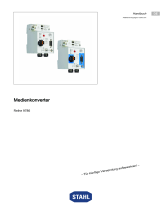 Stahl 9786 Bedienungsanleitung
Stahl 9786 Bedienungsanleitung
-
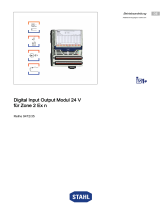 Stahl 9472 Bedienungsanleitung
Stahl 9472 Bedienungsanleitung
-
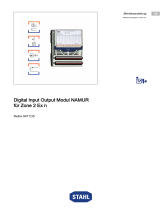 Stahl 9471 Bedienungsanleitung
Stahl 9471 Bedienungsanleitung
-
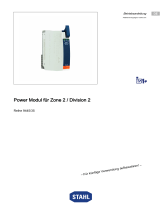 Stahl 9445/35 Bedienungsanleitung
Stahl 9445/35 Bedienungsanleitung
-
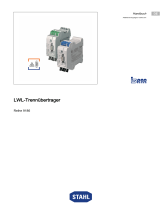 Stahl 9186 Bedienungsanleitung
Stahl 9186 Bedienungsanleitung
-
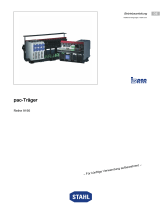 Stahl 9195 Bedienungsanleitung
Stahl 9195 Bedienungsanleitung
-
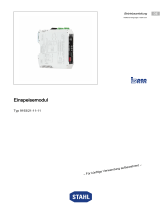 Stahl 9193 Bedienungsanleitung
Stahl 9193 Bedienungsanleitung
-
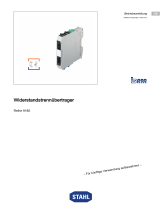 Stahl 9180 Bedienungsanleitung
Stahl 9180 Bedienungsanleitung
-
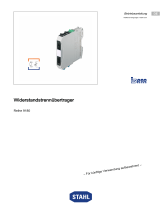 Stahl 9180 Bedienungsanleitung
Stahl 9180 Bedienungsanleitung
-
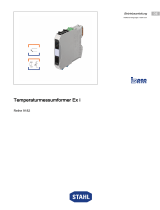 Stahl 9182 Bedienungsanleitung
Stahl 9182 Bedienungsanleitung












